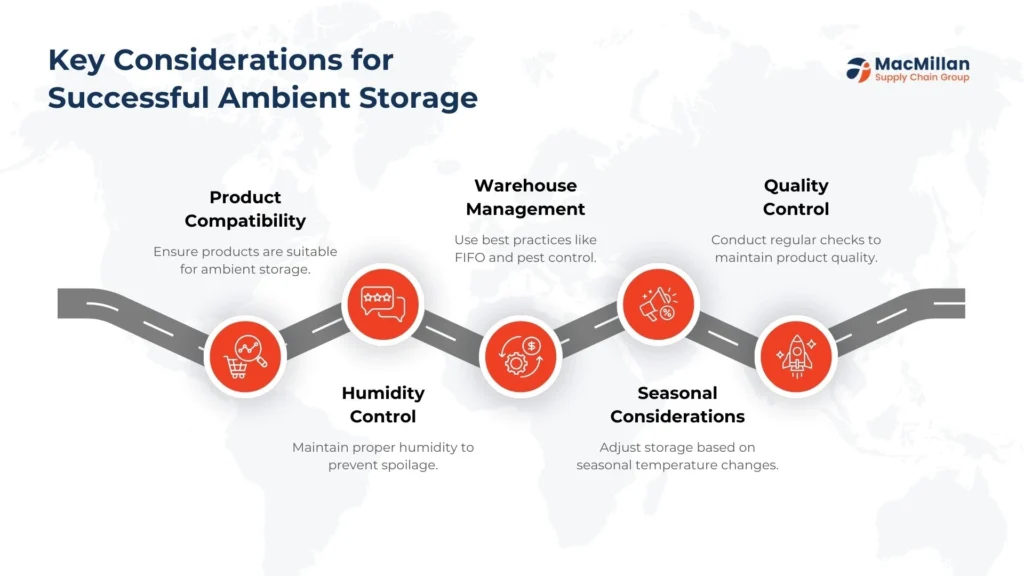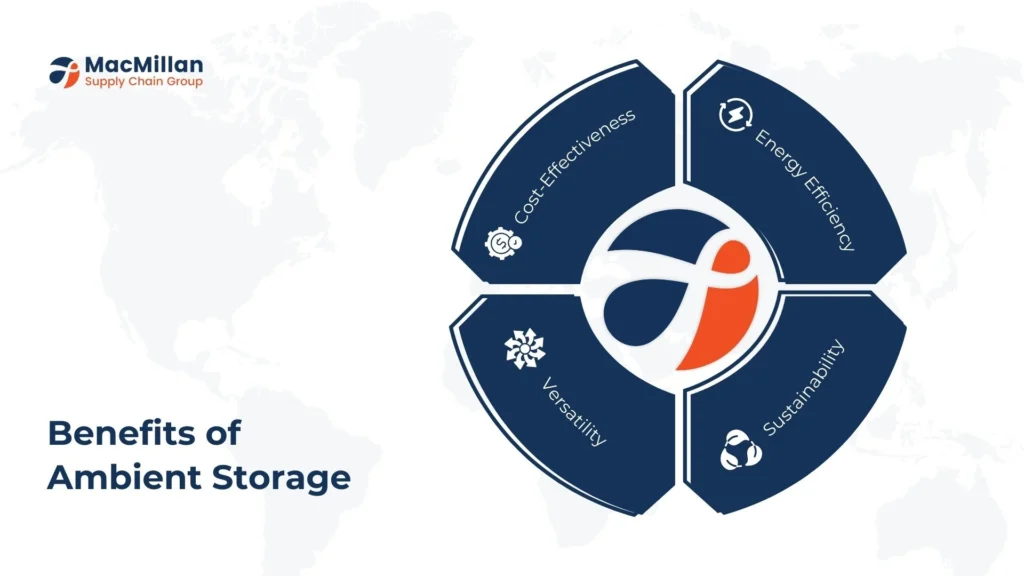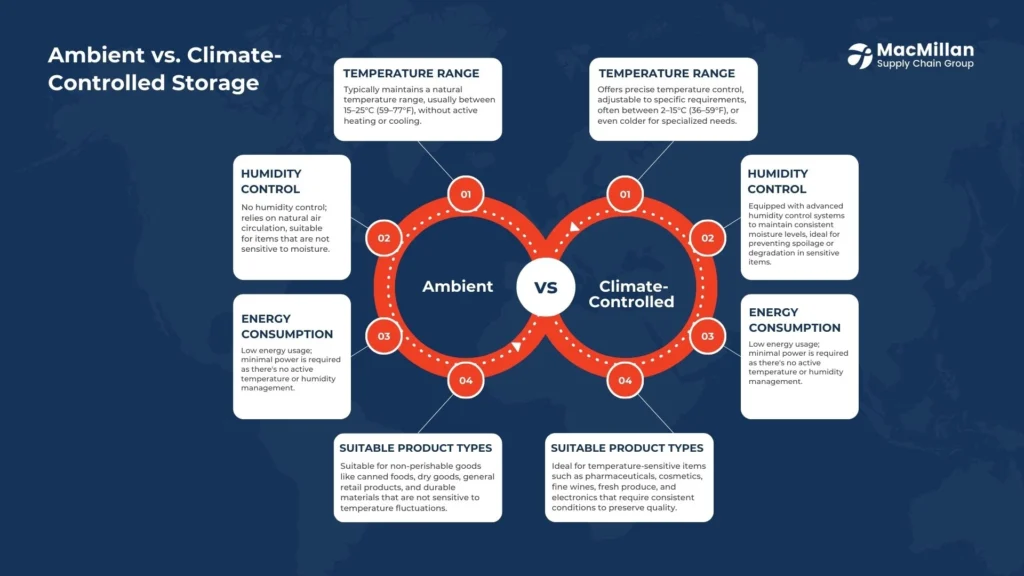A Quick Summary and Overview
Ambient storage is a practical and cost-effective choice for businesses seeking to store products that do not require refrigeration or freezing. This article delves into the benefits, key considerations, and best practices of ambient storage, explaining how it can enhance logistics efficiency and maintain product quality while reducing costs.

Introduction
In the competitive world of supply chain management, businesses are constantly looking for ways to optimize logistics operations. One such opportunity is through ambient storage solutions. Unlike temperature-controlled facilities, ambient storage offers a versatile and energy-efficient option for storing a wide range of products. By understanding the benefits and considerations of ambient storage, businesses can make informed decisions to enhance their supply chain efficiency and reduce costs. This article will explore the nuances of ambient storage, providing insights into its advantages and practical tips for integration with 3PL services.
Understanding Ambient Storage: What It Is and Why It Matters
Ambient storage involves keeping products in an environment that maintains controlled room temperatures, typically between 60°F to 80°F (15°C to 27°C). This storage type is ideal for non-perishable goods such as Consumer Packaged Goods (CPG), electronics, and clothing. It eliminates the need for costly refrigeration or climate-controlled setups, offering significant savings on storage and operating costs.
Advantages of mixing inventory types in ambient storage facilities add to flexibility and efficiency. Businesses can consolidate various product categories in one location, enhancing logistics operations while reducing transportation costs. Moreover, ambient storage is an eco-friendly choice, reducing energy usage, lowering carbon footprints, and aligning with green supply chain initiatives.

Advantages of Ambient Storage: A Deep Dive
One of the standout advantages of ambient storage is its cost-effectiveness. Without the need for specialized temperature-regulating equipment, ambient storage dramatically cuts down on overhead costs. Besides, the versatility of ambient storage cannot be overstated. It accommodates many products, allowing retailers and manufacturers to simplify logistics and improve operational efficiency.
Furthermore, energy efficiency is a key benefit. By minimizing energy use, companies not only save on utility expenses but also support sustainability by reducing environmental impact. Lower operational costs and a lighter ecological footprint make ambient storage a smart choice for forward-thinking businesses.
Key Considerations for Successful Ambient Storage
While ambient storage offers numerous benefits, businesses must address some critical considerations to ensure successful implementation. Product compatibility stands as the foremost aspect—it’s crucial to identify which goods can endure ambient temperatures without degradation. Monitoring and maintaining optimal humidity levels are pivotal to prevent issues such as mold growth or product spoilage.
Effective warehouse management, which includes regular cleaning, sanitation, pest control, and implementing FIFO inventory rotations, is essential. Finally, understanding seasonal fluctuations and the local climate of storage locations helps ensure that requirements remain stable year-round, thereby safeguarding product integrity.

Distinguishing Between Ambient and Climate-Controlled Storage
It’s vital to differentiate ambient storage from climate-controlled facilities, which offer precise temperature and humidity control for sensitive items. While ambient storage suits general, non-refrigerated products, certain high-value or delicate goods may require climate-controlled environments to prevent damage. Companies must evaluate products’ specific storage needs to choose the appropriate solution that ensures quality and compliance with industry standards.
Common Problems with Ambient Storage and Our Solutions
Common issues in ambient storage include improper inventory management, failing humidity control, and inadequate facility maintenance. These can lead to product damage, spoilage, or increased operational costs. At MacMillan Supply Chain, we’re committed to providing solutions that address these challenges.
Our ambient storage services offer advanced inventory management systems to maintain accurate stock levels and ensure timely rotations. We implement state-of-the-art humidity control measures, ensuring the environment stays within ideal parameters, and conduct regular facility inspections to uphold cleanliness and safety standards. By investing in cutting-edge technology and efficient storage practices, MacMillan Supply Chain aims to minimize disruptions and enhance supply chain reliability.
How Can Readers Avoid Problems and Implement Solutions?
To leverage ambient storage effectively, businesses should conduct a thorough assessment of their inventory needs. Selecting the right logistics partner is crucial to achieving seamless integration and optimal performance. Consider MacMillan Supply Chain as your strategic partner. With our expertise and robust storage solutions, you’ll avoid common pitfalls and ensure operations run smoothly. Contact us today to learn how ambient storage can transform your logistics strategy.
FAQs
Ambient storage involves storing goods at controlled room temperatures, typically between 60°F to 80°F (15°C to 27°C).
Ambient storage is ideal for products that do not require refrigeration or freezing, such as CPG products, food, electronics, and clothing.
By eliminating specialized temperature-controlled equipment, ambient storage significantly reduces costs, including energy savings and operational expenses.
Ambient storage reduces energy utility expenses, thus supporting a lower carbon footprint and aiding sustainability initiatives.
Factors like product compatibility, humidity control, and regular maintenance schedules are critical for optimal ambient storage management.
Ambient storage does not provide the stringent temperature and humidity regulation available in climate-controlled facilities, making it less suitable for sensitive items.
Absolutely, ambient storage can be part of a comprehensive supply chain strategy, integrating seamlessly with services like cross-docking and order fulfillment.
Quality control ensures products are stored in optimal conditions to maintain integrity and customer satisfaction.
Leveraging MacMillan's expertise in maintaining superior storage conditions can lead to cost savings and improved operational efficiency.
Proper humidity control prevents mold, corrosion, and other forms of product degradation, ensuring long-term storage safety.
In summary, ambient storage is a versatile and cost-effective solution for businesses looking to optimize their logistics. By understanding and addressing key considerations, companies can integrate this storage type into their supply chain strategy, achieving efficiency and sustainability. Contact MacMillan Supply Chain for tailored ambient storage solutions designed to meet your company's needs.




